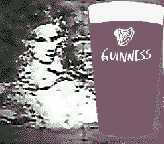- There are vast numbers of people on the Internet who aren't even using graphic
browsers -- they see text, and text only. All images show up as the stunningly
informative [IMAGE], or perhaps the equally evocative [INLINE] -- unless you
have had the forethought to include the attribute ALT="This is the cutest
picture of a cat you never did see." in your IMG tag.
 EXAMPLE: If you are using a graphics browser and all is right with the world,
you see a picture of Myself and one of my Favorites. If you are using a text
browser, or one of the Internet's Immortal Imps has interrupted transmission,
chewed on and corrupted my image file, or some other imaginative trick, you
see the words "Thalia, with Guinness". The code for this reads <IMG SRC="thalia.gif"
height=144 width=164 ALT="Thalia, with Guinness" ALIGN=right>
EXAMPLE: If you are using a graphics browser and all is right with the world,
you see a picture of Myself and one of my Favorites. If you are using a text
browser, or one of the Internet's Immortal Imps has interrupted transmission,
chewed on and corrupted my image file, or some other imaginative trick, you
see the words "Thalia, with Guinness". The code for this reads <IMG SRC="thalia.gif"
height=144 width=164 ALT="Thalia, with Guinness" ALIGN=right>
- Which brings up a tip about speed. Not everybody on the Web, regrettably,
is willing to wait five minutes to see all your stunning effects -- you would
be amazed to know how few are, really. But if you give them something
to begin to read, they might still be around when all the images finally download.
The way to do this is to include the WIDTH and HEIGHT attributes in every
IMG tag -- as I did above. This both makes the images load faster, and allows
the server to immediately begin filling in the text around the places where
the images will be.
- Not everyone using the internet has precisely your tastes
in music, or is presently in a position to indulge it. If a visitor to your
site suddenly finds "Boogie Nights" bursting from his speakers all over the
office floor in the middle of the morning, or waking the baby in the middle
of the night, he might not be back. It is considerate to place the controls
within his reach. [Music Controls]
Here is the code I used:
<EMBED SRC="daichi.mid" controls=smallconsole height=15 width=55
AUTOSTART=true LOOP=true VOLUME=32>
<FONT SIZE=-2>[Music Controls]</FONT>
<BGSOUND="daichi.mid" autostart=true loop=true VOLUME=32>- Frames can be lovely, frames can be useful -- and if someone whose browser is not frame-capable happens on your site, you might as well not have a webpage. Setting up an alternative for non-frame browsers is quick and easy -- after the </FRAMESET> tag, write <NOFRAMES>, then code the page that the no-frame browser will see, then write </NOFRAMES>. You can see an example of this in Seattle Jabberwalk. Feel free to look at the source code.
- For love and pity, if you are going to use Java scripts, test them out thoroughly against several kinds of browsers before uploading them. Personally, I get rather tired of pressing "OK" on the Java Error Message pop-up, just because I have a Netscape 2.02 and you have a Supercallifragelisticexpiallidocious. And if you are really depending on the input from a Java routine, be aware that your text-browser audience ain't gonna give it to you -- so provide an alternative form.
- Netscape 2.02 browsers are not going to see any of the colors you defined for your tables, rows, and columns. They are going to see only the color you set for the page as a whole in the BODY tag. If you set the overall page to black and set each particular cell to a different bright color, with black lettering in it, you would have a very vivid web page -- to advanced browsers. But to the older generation of browsers, you would be invisible -- a portrait of a black cat at midnight in the coal factory. And not all the old browsers are dead yet. According to my webpage stats, about 20% of the people visiting my pages use Netscape 2.x -- think of it as getting a 20% percent increase in traffic for a lot less effort than you'd spend getting listed in Yahoo, and use background graphics to make separate color areas on your screen.
You can use Bobby to test the accessibility of your webpage.
- I'm sure there's more. There are more sites that explain them, too. Feel free to email me with any suggestions.
- For other web-builder tips, I have links to a number of graphic and midi sites on my Credits and Fun Places to Visit page, and my Bard, in her other persona as an activist and web-builder, has put together a compilation of Beginner's Guides to World Wide Webbing at her site on Designing for Effective Activism on the Internet.
- New: Virus Warnings and Other Net Hoaxes
- Frames can be lovely, frames can be useful -- and if someone whose browser is not frame-capable happens on your site, you might as well not have a webpage. Setting up an alternative for non-frame browsers is quick and easy -- after the </FRAMESET> tag, write <NOFRAMES>, then code the page that the no-frame browser will see, then write </NOFRAMES>. You can see an example of this in Seattle Jabberwalk. Feel free to look at the source code.
